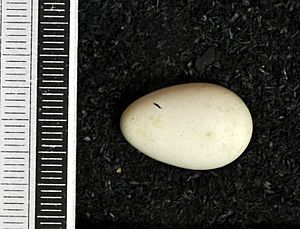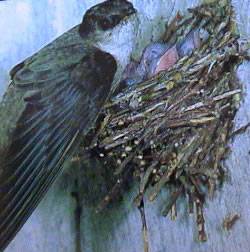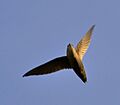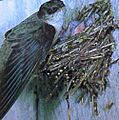Chimney swift facts for kids
Quick facts for kids Chimney swift |
|
|---|---|
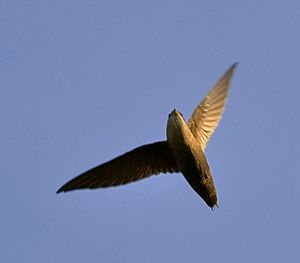 |
|
| Flying in Texas, United States | |
| Conservation status | |
| Scientific classification | |
| Genus: |
Chaetura
|
| Species: |
pelagica
|
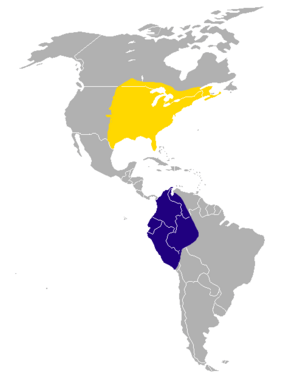 |
|
| Range of chimney swift Breeding range Wintering range | |
| Synonyms | |
|
Hirundo pelagica protonym |
|
The chimney swift (Chaetura pelagica) is a small, sooty gray bird with long, thin wings. It belongs to the swift family. This bird is related to the Vaux's swift and the Chapman's swift. Unlike most birds, it cannot perch on branches. Instead, it clings vertically to surfaces.
Chimney swifts mostly eat flying insects and spiders. They usually stay with the same mate for their whole lives. They build a special nest of twigs and their own saliva. This nest sticks to a vertical surface, usually inside a human-made structure like a chimney. The female swift lays 4 to 5 white eggs. The young birds hatch after about 19 days and leave the nest a month later. A chimney swift usually lives for about 4.6 years.
Contents
About the Chimney Swift's Name
When Carl Linnaeus first described the chimney swift in 1758, he thought it was a swallow. He named it Hirundo pelagica. People kept calling it names like "American Swallow" or "Chimney Swallow" for many years.
In 1825, James Francis Stephens moved this bird to the genus Chaetura. It has been there ever since. The chimney swift does not have any different types or subspecies. Its closest relative is the Vaux's swift. Scientists think these two birds came from a common ancestor. This ancestor was split into two groups by glaciers. Over thousands of years, these groups became two different species. The chimney swift is also related to the Chapman's swift.
The name Chaetura comes from two Ancient Greek words. Chaite means "bristle" or "spine," and oura means "tail." This is a good description because the swift's tail feathers have sharp, pointy ends. The second part of its scientific name, pelagica, means "of the sea." This likely refers to its traveling lifestyle, not the sea itself. Its common name, "chimney swift," describes where it likes to nest and how fast it flies.
What Does a Chimney Swift Look Like?
The chimney swift is a medium-sized bird. It is about 12 to 15 cm (5 to 6 in) long. Its wingspan is 27 to 30 cm (11 to 12 in). It weighs about 17 to 30 g (0.6 to 1.1 oz). Males are usually a little heavier than females. Both sexes look the same.
Adult swifts are dark sooty olive on top and grayish brown underneath. Their throat is a bit lighter. Their beak, feet, and legs are black. Their eyes are dark brown. Young swifts look very similar to adults.
Wings and Flight
The chimney swift has long, thin, curved wings. They stick out about 1.5 cm (0.6 in) past its tail when folded. Its wingtips are pointed, which helps it fly smoothly. The bones in its wings are short near the body and long further out. This helps the bird flap its wings very quickly.
When flying, it holds its wings stiffly. It switches between fast, shaky flaps and longer glides. People often describe its flight shape as a "cigar with wings." Even though it looks like its wings flap unevenly, studies show they flap together. Its flight is very fast and changes direction often.
Legs and Tail
Like all swifts, the chimney swift has very short legs. Its feet are small but strong, with short toes and sharp, curved claws. It has three toes pointing forward and one pointing back. However, it can move its back toe forward to get a better grip. Unlike most birds, its legs and feet are smooth, not scaly.
Its tail is short and square, about 1.9 to 2.15 cm (0.75 to 0.85 in) long. All ten tail feathers have shafts that stick out about 0.5 cm (0.2 in) beyond the feathery part. These stiff points help the bird prop itself against vertical surfaces.
Eyes and Beak
The chimney swift has large, deep-set eyes. Small patches of stiff, black feathers protect its eyes. These feathers can change angle, which might help reduce glare. The swift is far-sighted. Like some birds of prey, it has two special spots in each eye called foveas. These spots help it see very clearly. It can focus both eyes at once, or even one eye by itself.
Its beak is very small, only about 5 mm (0.2 in) long. But it can open its mouth very wide, all the way back past its eyes. This helps it catch insects in the air.
Similar Birds
The chimney swift looks a lot like the Vaux's swift. But the chimney swift is a bit bigger, with longer wings and tail. It also flaps its wings slower and soars more. Its chest and rump are usually darker than the Vaux's swift. The chimney swift is smaller, lighter, and has a shorter tail than the black swift. In Central America, it is most similar to Chapman's swift. However, the chimney swift is lighter in color and has a clearer difference between its pale throat and darker belly.
Where Chimney Swifts Live
Chimney swifts breed in the eastern half of the United States and southern Canada. They migrate to South America for the winter. They are sometimes seen in the western U.S. and have been found in places like Anguilla, Barbados, Greenland, Jamaica, Portugal, the United Kingdom, and the United States Virgin Islands. They live in open areas, savannas, wooded hills, and humid forests.
People only found out where chimney swifts spent the winter in 1944. This happened when bands from birds tagged in North America were found in Peru. An local person in Peru was wearing the bands as a necklace.
How Chimney Swifts Behave
Chimney swifts like to be in groups and are rarely seen alone. They usually hunt in groups of two or three. They migrate in loose groups of 6 to 20 birds. After the breeding season, they sleep in huge groups of hundreds or thousands of birds.
Like all swifts, they are amazing flyers and are rarely seen resting. They drink by skimming the surface of water with their beak. They also bathe by gliding over water, briefly touching their chest to the surface, then flying off and shaking their feathers. Pilots have seen them flying more than a mile high. They cannot perch upright like most birds. Instead, they cling to vertical surfaces.
If a chimney swift is disturbed while resting, it will clap its wings loudly against its body. This can make a loud "thundering" sound if many birds are disturbed. This sound is thought to scare away predators.
What Chimney Swifts Eat
The chimney swift finds its food while flying. Studies show that 95 percent of its food is flying insects. This includes different kinds of flies, ants, wasps, bees, whiteflies, aphids, scale insects, stoneflies, and mayflies. They also eat spiders that float in the air on their threads. They are important because they eat pests like the red imported fire ant.
Researchers believe that a pair of adult swifts feeding three young birds eat about 5,000 to 6,000 housefly-sized insects every day. Like many birds, the chimney swift sometimes coughs up pellets. These pellets contain parts of insects that they could not digest.
During the breeding season, chimney swifts mostly hunt within 0.5 km (0.3 mi) of their nest. However, they can fly up to 6 km (3.7 mi) away to find food. Most of their food is caught in the air. But some food is picked from tree leaves. The bird hovers near branches or drops through the top of the trees. Chimney swifts usually fly quite high. But they fly lower when it is cold or rainy.
They often hunt in small groups and sometimes hunt with swallows, like barn swallows. They are usually among the lower flying birds in mixed groups. There is one report of a chimney swift trying to steal a dragonfly from a purple martin. They have also been seen chasing other purple martins. Generally, they hunt during the day and stay active into the early evening. But during migration, they have been seen feeding after dark over brightly lit buildings.
Chimney swifts gain weight twice a year. Once at the start of breeding season, and more before they migrate south in the autumn. Their lowest weights are usually during the breeding season. At this time, they also start to shed all their old feathers. Their weight gain before migration is smaller than some other birds. This suggests they need to stop and eat along their journey.
How Chimney Swifts Breed
The chimney swift is a monogamous bird, meaning it usually mates for life. However, a few birds do change partners. Mating pairs fly together, gliding with their wings held up in a "V" shape. They sometimes rock from side to side. Breeding birds arrive in the southern U.S. as early as mid-March. They arrive in Canada as late as mid-May.
Before Europeans came to North America, chimney swifts nested in hollow trees. Now, they almost always use human-made structures. A few still nest in hollow trees or old woodpecker nests. But most nests are found inside chimneys. Smaller numbers are found in airshafts, dark corners of unused buildings, cisterns, or wells.
The nest is a shallow cup made of sticks. The birds collect these sticks while flying, breaking them off trees. They glue the sticks together and to a vertical surface using a lot of their saliva. During breeding season, the salivary glands of each adult bird more than double in size.
Unlike some swifts that mate in the air, chimney swifts mate while clinging to a vertical surface near their nest. They mate every day until all the eggs are laid. The female usually lays 4 to 5 eggs, but it can be from 2 to 7. The eggs are long, oval, shiny, and white. They measure about 20 x 13 mm (0.8 x 0.5 in). Each egg weighs almost 10 percent of the female's body weight. Both parents sit on the eggs, which hatch after 19 days. Baby chimney swifts are altricial. This means they are born naked, blind, and helpless. Young birds leave the nest after one month.
The average chimney swift lives for 4.6 years. But one swift was known to live for more than 14 years. It was tagged as an adult and found again 12.5 years later.
Dangers and Pests
Mississippi kites, peregrine falcons, and merlins are raptors that can catch adult chimney swifts in flight. They are some of the only birds fast enough to do so. Eastern screech-owls have been seen attacking swift groups. Other animals like eastern rat snakes, northern raccoons, and tree squirrels also attack them. These animals mostly take young birds, but sometimes adult nesting birds too.
When disturbed by predators (including humans), adult chimney swifts slap their wings together. This makes a very loud noise called "booming" or "thunder noises." Young birds make a loud, raspy raah, raah, raah sound when disturbed. Both sounds seem to scare away possible predators.
The chimney swift can carry different kinds of tiny living things, both inside and outside its body. It is the main host for a type of nematode worm, a kind of feather mite, and a type of bird louse. It can also carry a tapeworm. Its nest can host an insect called Cimexopsis nyctali, which is similar to a bed bug. This insect can sometimes become a pest in houses.
Sounds Chimney Swifts Make
The chimney swift has a twittering call. It is a fast series of hard, high-pitched chirps. Sometimes, it makes single chirps.
Protecting Chimney Swifts
In 2010, the International Union for the Conservation of Nature changed the chimney swift's status from "least concern" to "near threatened." This means they were getting closer to being at risk. In 2018, they changed it again to "vulnerable." This means the species is at risk of becoming endangered.
Even though there are about 7,700,000 chimney swifts worldwide, their numbers have dropped a lot in most places. The reasons for this decline are not fully clear. It might be because of changes in insect populations due to pesticide use in the early 1900s. In Canada, they are listed as threatened. In the U.S., the chimney swift is protected by the Migratory Bird Treaty Act of 1918. This means that birds or their nests cannot be removed from chimneys without a special permit.
Some people think that chimney swift numbers may have grown when European settlers came to North America. This is because settlers built many chimneys, which gave the swifts more places to nest.
Sometimes, after sudden drops in temperature, chimney swifts hunt low over concrete roads. They are likely following insects drawn to the warmer road. This makes them more likely to crash into cars. Strong storms, like hurricanes, during migration can also seriously affect their survival. More than 700 swifts died after being caught in Hurricane Wilma in 2005. They were swept as far north as Atlantic Canada and Western Europe. The next year, the number of swifts in Quebec, Canada, dropped by 62 percent. The total population in that province was cut in half.
How We Learned About Chimney Swifts
In 1899, Mary Day from New Jersey watched a pair of chimney swifts nesting in a chimney. She noted that the eggs hatched after 19 days. The first detailed study of chimney swifts began in 1915 by Althea Sherman in Iowa. She was a self-taught bird expert.
Sherman had a 28-foot-tall tower built. It looked like a chimney but had ladders and peepholes for watching. Chimney swifts nested in her tower. For over fifteen years, she carefully wrote down her observations, filling over 400 pages. Sherman said that even though she didn't know much about swift nesting when she designed the tower, it turned out to be perfect for her studies.
Images for kids
See also
 In Spanish: Vencejo de chimenea para niños
In Spanish: Vencejo de chimenea para niños




